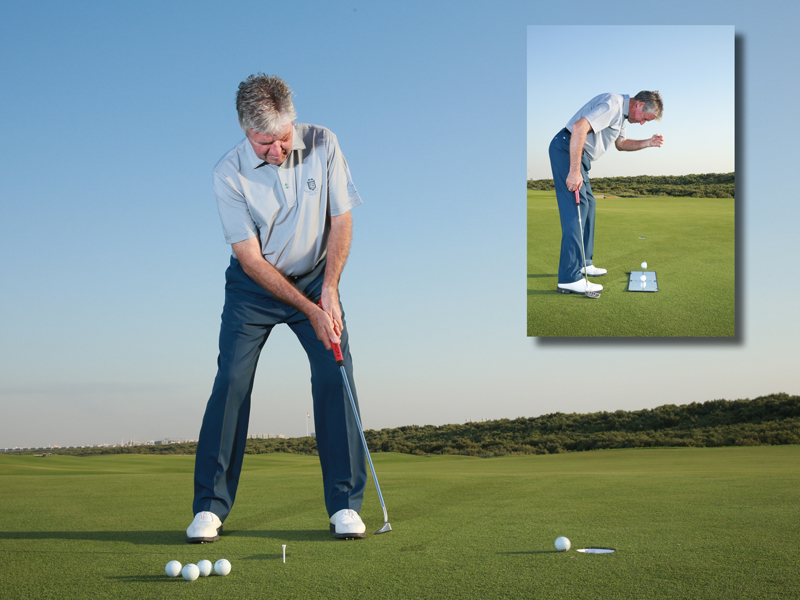How to check your eyeline


In this exclusive video, Golf Monthly Top 25 Coach Andrew Reynolds explains how to check your eyeline when putting for much stronger rolls
In my experience the best way to split any practice putting session is to devote half of it to fundamentals, like how to check your eyeline and the other half to feel and competitive practice. If you are struggling with your putting, think about investing in a mirror training aid like the one shown here. The first thing to check is whether your shoulders are parallel to your ball-to-target line. This is more important than where your feet are aiming because the position of your body will determine path of the stroke. Find a straight putt, take care to line up properly and hit a series of putts checking your alignment in the mirror before each one. Alternatively, you can lay a couple of alignment sticks or shafts down on the ground to help you check your shoulder alignment. This will get you in the habit of addressing the ball in the best way possible, increasing your chances of holing out.
How Tour Players Practice Putting
How to check your eyeline
One of the areas where people often go wrong without realising is with their eyeline. A good question to ask yourself is; do you read the putt one way when looking form behind the ball and another way when in the address position? If so, this is usually a sign that your eyes are not directly over the ball and therefore you need to know how to check your eyeline. This is an essential fundamental to good putting and the best way to check it is to take your address position and then drop a second ball from the bridge of your nose. If your eyes are in the right position it should hit the ball on the ground.
Watch more putting tips videos
5 x 5 Test
Subscribe to the Golf Monthly newsletter to stay up to date with all the latest tour news, equipment news, reviews, head-to-heads and buyer’s guides from our team of experienced experts.
Now that you have devoted time specifically to the fundamentals, it’s time to use some drills designed to create pressure as you practice. The first is the 5x5 test. Find a flat part of the green and put your putter on the ground, with the butt end at the hole and place a tee peg at the point where the grip starts. Now measure four more putter grip lengths going away from the hole as I have done here. The tees should all be roughly a foot apart. The aim is simple, can you hole 25 consecutive putts. Hole five from the first spot and move back to the next point and so on, if you miss one, you should start again from the beginning. Take a note of how many times you had to start again and this will become the benchmark for future practice sessions.
Putter length test
When you are faced with a makeable birdie putt of mid to long range, there is an optimum pace at which the ball should run at the hole. The basic rule is that the ball should be running firmly enough to stay online over any imperfections on the green without rolling too fast and lipping out. If you miss, you’ll be faced with a putt of a couple of feet. Of course, it is worth practising that shorter, second putt so you can confidently roll your approach putts at the hole. So measure a putter’s length and try to hole 25 consecutive putts. The more you hole, the more the pressure mounts. I once had a pupil who holed a thousand consecutive putter length putts… He went on to play on Tour!
Watch more short putting drills videos
Round the clock & ladder tests
These are two of the oldest and best drills in the book. The round the clock drill is best done around a hole with a small amount of slope. Measure a putter’s length around the hole and place a ball at each point of a clockface. You should be able to hole all 12 consecutively. If you miss, you start again. With the ladder drill, place three balls at 3ft, 4ft and 5ft away. You should be able to hole all nine without missing. Both drills force you to run through your routine before hitting each ball. As soon as your focus slips and you become sloppy, you miss. They are a huge help in preparing you for the strain and pressure of competition.

In July 2023, Neil became just the 9th editor in Golf Monthly's 112-year history. Originally working with the best coaches in the UK to produce instruction content, he has also presented many Golf Monthly videos looking at all areas of the game from Tour player interviews to the rules of golf.
Throughout his time with the brand he has also covered equipment launches that date back well over a decade. He clearly remembers the launch of the Callaway and Nike square drivers as well as the white TaylorMade driver families, such as the RocketBallz! If you take a look at the Golf Monthly YouTube channel, you'll see his equipment videos dating back over a decade! He has also conducted 'What's In The Bag' interviews with many of the game's best players like Rory McIlroy, Dustin Johnson and Jon Rahm. Over the years, Neil has tested a vast array of products in each category and at drastically different price-points.
Neil is currently playing: Driver: TaylorMade Stealth Plus Fairway Wood: Titleist TSR2 Hybrid: Titleist TS3 Irons: PING Blueprint S (4&5), PING Blueprint T (6-PW) Wedges: Titleist Vokey SM7 50˚, 54˚, 60˚ Putter: Odyssey Triple Track Ten Ball: Titleist Pro V1X